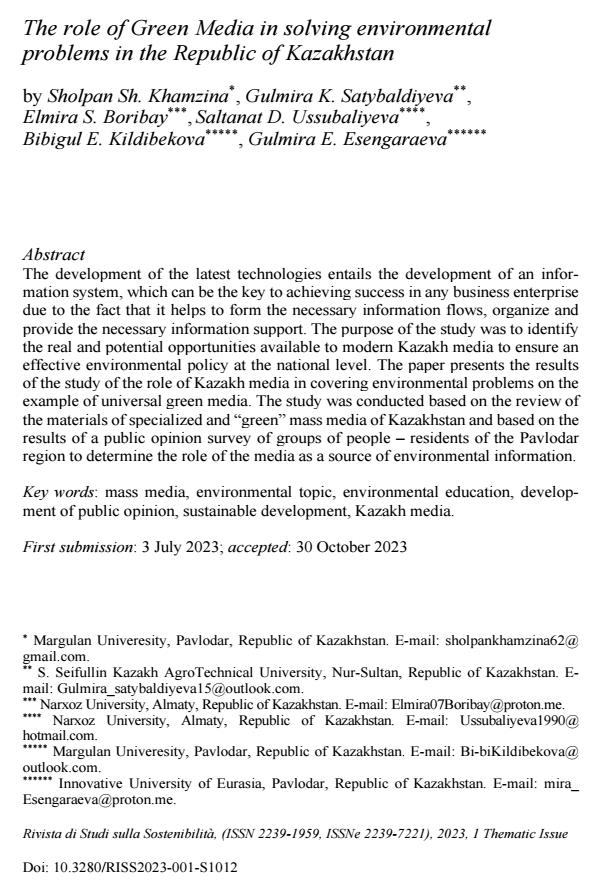The role of Green Media in solving environmental problems in the Republic of Kazakhstan
Titolo Rivista RIVISTA DI STUDI SULLA SOSTENIBILITA'
Autori/Curatori Sholpan Sh. Khamzina, Gulmira K. Satybaldiyeva, Elmira S. Boribay, Saltanat D. Ussubaliyeva, Bibigul E. Kildibekova, Gulmira E. Esengaraeva
Anno di pubblicazione 2023 Fascicolo 2023/1 T.
Lingua Inglese Numero pagine 15 P. 183-197 Dimensione file 117 KB
DOI 10.3280/RISS2023-001-S1012
Il DOI è il codice a barre della proprietà intellettuale: per saperne di più
clicca qui
Qui sotto puoi vedere in anteprima la prima pagina di questo articolo.
Se questo articolo ti interessa, lo puoi acquistare (e scaricare in formato pdf) seguendo le facili indicazioni per acquistare il download credit. Acquista Download Credits per scaricare questo Articolo in formato PDF

FrancoAngeli è membro della Publishers International Linking Association, Inc (PILA)associazione indipendente e non profit per facilitare (attraverso i servizi tecnologici implementati da CrossRef.org) l’accesso degli studiosi ai contenuti digitali nelle pubblicazioni professionali e scientifiche
The development of the latest technologies entails the development of an infor- mation system, which can be the key to achieving success in any business enterprise due to the fact that it helps to form the necessary information flows, organize and provide the necessary information support. The purpose of the study was to identify the real and potential opportunities available to modern Kazakh media to ensure an effective environmental policy at the national level. The paper presents the results of the study of the role of Kazakh media in covering environmental problems on the example of universal green media. The study was conducted based on the review of the materials of specialized and "green" mass media of Kazakhstan and based on the results of a public opinion survey of groups of people - residents of the Pavlodar region to determine the role of the media as a source of environmental information.
Parole chiave:mass media, environmental topic, environmental education, develop- ment of public opinion, sustainable development, Kazakh media.
- ЭКОЛОГИЯЛЫҚ БІЛІМ БЕРУ АРҚЫЛЫ ЭКОМӘДЕНИЕТТІ ҚАЛЫПТАСТЫРУ ТҰРАҚТЫ ДАМУ МАҚСАТТАРЫНА ҚОЛ ЖЕТКІЗУДІҢ НЕГІЗІ РЕТІНДЕ Гульмира Сатыбалдиева , Эльмира Бөрібай , Айжан Утарбаева , in Izdenister natigeler /2024 pp.172
DOI: 10.37884/4-2024/17
Sholpan Sh. Khamzina, Gulmira K. Satybaldiyeva, Elmira S. Boribay, Saltanat D. Ussubaliyeva, Bibigul E. Kildibekova, Gulmira E. Esengaraeva, The role of Green Media in solving environmental problems in the Republic of Kazakhstan in "RIVISTA DI STUDI SULLA SOSTENIBILITA'" 1 T./2023, pp 183-197, DOI: 10.3280/RISS2023-001-S1012